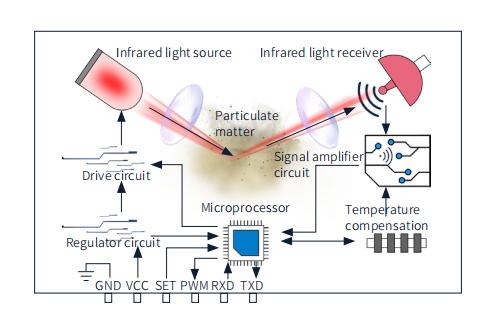
In the late 1990s, Bill Gates spent a huge amount of money to build the "Future House". This lakeside villa covers n area of about 6,600 square meters and took 7 years to be carefully built. Up to US$113 million, realizing the perfect integration of smart home and high technology.

Bill Gates' Future House
The door of the "Future House" is equipped with a weather sensor, which can control the indoor temperature and ventilation conditions according to various weather indicators. The kitchen is equipped with fully automatic cooking equipment, and a computer system for checking the body is installed in the toilet. In the garden, through advanced Sensing equipment can provide targeted, fully automatic watering and fertilizing based on the growth of plants.
Bill Gates' "Future House" can be called the originator of smart homes. All home appliances and other facilities in the "Future House" integrate communication and information technology, cloud computing, IOT, audio and video technology, etc., with precise sensing, Decision-making, execution and other capabilities can be controlled remotely and can replace part of consumers' decision-making, bringing a more convenient, comfortable and safe life experience.
Bill Gates' "Future House" is a model of digitalization and intelligence of homes and home appliances, leading a new wave of smart home and smart home appliance technology development in the new era.
Smart home appliances & sensors
Compared with traditional home appliances, smart home appliances require upstream components, information technology, etc. as support. Hardware covers chips, sensors and other components, communication modules such as WIFI, Bluetooth and ZigBee, intelligent controllers and other middleware, system and technical support includes AI technology, communication service providers, cloud service platforms and operating systems, etc.
In smart home appliances, sensors play an indispensable role and are the eyes, ears, nose, tongue, and skin of various smart home appliances.
At the same time, the application methods of sensors are also different in different home appliances. Pressure sensors can be used in water level switches or more complex devices, such as monitoring the amount of foam in washing machines and dryers, smart water purifiers, water heaters, and dishwashers. Water quality sensors are used to monitor water quality in water purifiers. Monitoring parameters include turbidity, color, surface tension, detergent solubility, PH value, etc., and determine the number of rinse cycles based on the monitored data. PM sensors are widely used in air purifiers, fresh air systems, fresh air air conditioners and other equipment.
Each sensor has its own strengths and senses different data to build multi-dimensional minimalist, extremely enjoyable and fast systematic solutions, bringing a variety of high-control to people's home life, a leap-forward experience with high intelligence and high reliability.
Infrared PM sensor
With the rapid development of human society, environment and air pollution have attracted increasing attention. Various typical pollutants, such as particulate matter , ozone O3, nitrogen dioxide NO2, sulfur dioxide SO2, and carbon monoxide CO, threaten human health.
According to WHO statistics, in 2019, more than 90% of the global population lived in areas where pollutant concentrations exceeded the level of 10 micrograms per cubic meter specified in the 2005 WHO air quality guidelines. How to improve air quality and improve the environment Detection has become an important issue for the sustainable development of human society.
PM2.5 sensor, can detect the diameter and concentration of particulate matter in the air. Today, the editor will recommend to everyone a very cost-effective infrared PM sensor.
The light source of the infrared PM sensor is an infrared LED light source. According to the principle of light scattering, the LED emits light and encounters dust to produce reflected light. The photosensitive detector detects the intensity of the reflected light and determines the concentration of dust based on the size of the pulse signal. When there is no detection When dust is detected, the photosensitive detector outputs a low pulse. Conversely, when dust is detected, the photosensitive detector outputs a high pulse.
MFrontier infrared PM sensors are divided into self-priming infrared PM sensors and passive infrared PM sensors according to the way gas enters the sensor. Among them, the MPM20-AH infrared PM sensor is self-priming and the MPM30 series is passive.
Self-priming infrared dust sensor
Product principle:

Product advantages:
Built-in heater, automatic air intake without the need for an air pump, and air quality can be detected at any time without interference from the outside world
Automatic temperature compensation calibration, high detection accuracy
Mini and compact, easy to integrate into end products
Anti-static injection molded shell to shield electromagnetic interference
Scientific structural design, no fear of dust accumulation, easy manual dust removal in 3 seconds.
Application areas:
Smart home appliances Fresh air system HVAC Automotive electronics Smart building Industrial inspection
Passive infrared PM sensor
Product principle:

Product advantages:
Scientific dust compensation algorithm, high detection accuracy
Wide measuring range and short response time
Excellent stability and consistency
Low power consumption and low noise
Application:
Smart home appliances Fresh air system HVAC Smart building
MFrontier self-priming and passive infrared dust sensors have their own merits. In the field of smart home appliances, compared with laser dust sensors, the overall performance advantage is not outstanding, but the cost-effectiveness advantage is outstanding, and they have won the favor of many smart home appliance brands.
The MPM20-AH and MPM30 series not only have excellent quality, but also have outstanding algorithm advantages. They can be used in automotive electronics, HVAC, smart buildings, fresh air systems and other fields, and can be customized according to customer products and achieve mass customization according to the personalized needs of the application environment!
Share